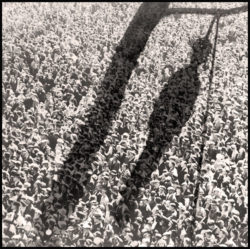Lynching
Lynching, an extralegal method of maintaining racial boundaries (and terror), has a long, bloody history in Louisiana.

Courtesy of Library of Congress Prints and Photographs Division
Depiction of a lynching. Unidentified
Editor’s Note: Warning, this entry contains graphic imagery.
From 1882 to 1936 alone, an estimated 4,673 lynchings took place across America. Of that number, at least 389 occurred in Louisiana, of which 333 were committed against African Americans; only Georgia, Mississippi, and Texas witnessed more lynching violence during the period. For a time, the top four lynching counties in America were Ouachita, Caddo, Bossier, and Morehouse parishes in north Louisiana. Even these shocking numbers fail to tell the whole story, however, since many lynchings went unreported or were treated as regular homicides instead of racially charged mob activities.
Lynching represents an extralegal form of punishment undertaken by a group of individuals for perceived transgressions handled outside of legal system. While, in the American West, cattle rustling often served as the trigger for violent mob action, in the South lynching most often occurred following a violation of regional racial etiquette. Frequently, alleged criminals awaiting their date before a judge were forcibly removed from a jail by a mob, often while local law enforcement officials looked on, and taken to a remote location where they faced execution. Although the hangman’s noose was the preferred tool, many other brutal methods, including immolation, were utilized. Far from spur-of-the-moment affairs, many lynchings were premeditated events witnessed by large crowds, whose members frequently took home “souvenirs” from the spectacle.
Lynching in Late Nineteenth-Century Louisiana
In Louisiana, as in the South in general, the number of lynchings spiked following Reconstruction, though signs of the problem emerged far earlier. As Louisiana struggled with the new political order imposed during Reconstruction, many disenfranchised whites struck out at Republican Party faithfuls regardless of their race. Terrorist groups such as the White League spread fear throughout the state, mixing threats with violence. In an 1884 incident known as the Coushatta Massacre, members of the league lynched four blacks and six white Republicans. The violence that engulfed the state and the South as a whole played a pivotal role in turning Northern opinion against Reconstruction.
When Reconstruction finally ended in 1877, Louisianans faced a different sequence of challenges and a more aggressive and racially motivated spate of lynchings. As the 1880s dawned, a new era of violence ensued as Bourbon Democrats strengthened their hold on power in Louisiana. White supremacy represented a central tenant of their platform and led to even greater levels of violence as they tried to reverse the advances made by African Americans during Reconstruction. Capitalizing on rumors that black crime had expanded after the abolition of slavery, Bourbon leaders and their followers demanded that whites take extraordinary steps to prevent black “retrogression” to their innate state of “barbarism.” As a result, the number of lynchings soared across the South and, for a twenty-year period, hundreds of lives were taken. Lynch mobs often justified their actions as attempts to defend white Southern womanhood from “libidinous” black males, but statistics reveal that even at the height of lynch law in America, only about 25 percent of all lynchings were for alleged rapes.
Although most lynching victims were African Americans, other “outsiders” sometimes ran afoul of Louisiana’s white ruling class. In 1891, at the height of the lynching epidemic in Louisiana, the lynching of eleven Italians in New Orleans for allegedly killing Police Chief David Hennessey garnered the most attention. It marked the first of several attacks on the rapidly expanding Italian community in southeastern Louisiana. Further north, in the Madison Parish village of Tallulah, five Sicilians were killed because of little more than rumors that the men possessed fiery and violent tempers. Scant evidence existed that the men, all of whom sold fruits and vegetables, were anything but law-abiding citizens. At a time when outsiders were viewed with suspicion, however, the economic success of the Sicilians—when many in the surrounding community suffered—heightened hostility toward them.
Lynching in Twentieth-Century Louisiana
In the early twentieth century, the number of lynchings generally decreased as state and local authorities began cracking down on the crime, partly because of outside pressure. The establishment of a legally sanctioned system of racial segregation, known as Jim Crow, decreased contact between the races and contributed to this reduction, albeit unintentionally. Once this system was firmly ensconced, the need for frequent demonstrations of terror gradually dissipated. With the ratification of the Louisiana Constitution of 1898, blacks had been effectively removed from the political process, their voices silenced by a series of laws and voting requirements that made it virtually impossible for them to participate in state politics. At the same time, in the wake of the U.S. Supreme Court’s decision in Plessy v. Ferguson (1896), segregation statutes were extended and formalized, further codifying a new Southern social order predicated on white supremacy. Even as violence lessened, however, the threat of further bloodletting remained close to the surface. Transgressions, whether large or small, could prompt a return of lynch law. From rape to catcalling and everything in between, violence often became the answer when blacks “stepped out of line.”
By the end of World War II, lynching, as understood in the context of the 1880s and 1890s, had been dramatically reduced, a fact that helped undermine federal efforts to enact anti-lynching legislation in the period. The specter of racial violence nonetheless remained, but the carnival quality of the prototypical late nineteenth-century lynching gave way to brutal clandestine murders committed away from the glare of large crowds in the mid-twentieth century. As the push for racial equality expanded during the civil rights movement, racial violence and intimidation grew along with it. Though the form this lawlessness differed from that of previous eras, its origins were firmly rooted in the age when lynch law reigned supreme.
